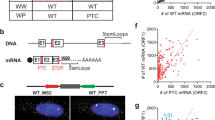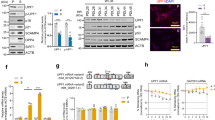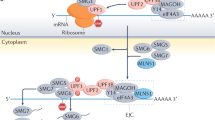Abstract
Premature termination codons induce rapid transcript degradation in eukaryotic cells through nonsense-mediated mRNA decay (NMD)1,2. This pathway can modulate phenotypes arising from nonsense or frameshift mutations, but little is known about the physiologic role of NMD in higher eukaryotes. To address this issue, we examined expression profiles in mammalian cells depleted of Rent1 (also called hUpf1), a factor essential for NMD3,4. Upregulated transcripts included those with upstream open reading frames in the 5′ untranslated region, alternative splicing that introduces nonsense codons or frameshifts, introns in the 3′ untranslated region or selenocysteine codons. Transcripts derived from ancient transposons and endogenous retroviruses were also upregulated. These RNAs are unified by the presence of a spliced intron at least 50 nucleotides downstream of a termination codon, a context sufficient to initiate NMD5. Consistent with direct regulation by NMD, representative upregulated transcripts decayed more slowly in cells deficient in NMD. In addition, inhibition of NMD induced by amino acid starvation upregulated transcripts that promote amino acid homeostasis. These results document that nonsense surveillance is a crucial post-transcriptional regulatory event that influences the expression of broad classes of physiologic transcripts, has been functionally incorporated into essential homeostatic mechanisms and suppresses expression of evolutionary remnants.
This is a preview of subscription content, access via your institution
Access options
Subscribe to this journal
Receive 12 print issues and online access
$259.00 per year
only $21.58 per issue
Buy this article
- Purchase on SpringerLink
- Instant access to full article PDF
Prices may be subject to local taxes which are calculated during checkout


Similar content being viewed by others
References
Wagner, E. & Lykke-Andersen, J. mRNA surveillance: the perfect persist. J. Cell Sci. 115, 3033–3038 (2002).
Hentze, M.W. & Kulozik, A.E. A perfect message: RNA surveillance and nonsense-mediated decay. Cell 96, 307–310 (1999).
Mendell, J.T., ap Rhys, C.M. & Dietz, H.C. Separable roles for rent1/hUpf1 in altered splicing and decay of nonsense transcripts. Science 298, 419–422 (2002).
Sun, X., Perlick, H.A., Dietz, H.C. & Maquat, L.E. A mutated human homologue to yeast Upf1 protein has a dominant-negative effect on the decay of nonsense-containing mRNAs in mammalian cells. Proc. Natl. Acad. Sci. USA 95, 10009–10014 (1998).
Nagy, E. & Maquat, L.E. A rule for termination-codon position within intron-containing genes: when nonsense affects RNA abundance. Trends Biochem. Sci. 23, 198–199 (1998).
Inoue, K. et al. Molecular mechanism for distinct neurological phenotypes conveyed by allelic truncating mutations. Nat. Genet. 36, 361–369 (2004).
Frischmeyer, P.A. & Dietz, H.C. Nonsense-mediated mRNA decay in health and disease. Hum. Mol. Genet. 8, 1893–1900 (1999).
He, F. et al. Genome-wide analysis of mRNAs regulated by the nonsense-mediated and 5′ to 3′ mRNA decay pathways in yeast. Mol. Cell 12, 1439–1452 (2003).
Lelivelt, M.J. & Culbertson, M.R. Yeast Upf proteins required for RNA surveillance affect global expression of the yeast transcriptome. Mol. Cell. Biol. 19, 6710–6719 (1999).
Zhang, J., Sun, X., Qian, Y. & Maquat, L.E. Intron function in the nonsense-mediated decay of beta-globin mRNA: indications that pre-mRNA splicing in the nucleus can influence mRNA translation in the cytoplasm. RNA 4, 801–815 (1998).
Zhang, S., Ruiz-Echevarria, M.J., Quan, Y. & Peltz, S.W. Identification and characterization of a sequence motif involved in nonsense-mediated mRNA decay. Mol. Cell. Biol. 15, 2231–2244 (1995).
Chen, B.P., Liang, G., Whelan, J. & Hai, T. ATF3 and ATF3 delta Zip. Transcriptional repression versus activation by alternatively spliced isoforms. J. Biol. Chem. 269, 15819–15826 (1994).
Aubel, C., Chabanon, H., Carraro, V., Wallace, H.M. & Brachet, P. Expression of spermidine/spermine N1-acetyltransferase in HeLa cells is regulated by amino acid sufficiency. Int. J. Biochem. Cell. Biol. 35, 1388–1398 (2003).
Moriarty, P.M., Reddy, C.C. & Maquat, L.E. Selenium deficiency reduces the abundance of mRNA for Se-dependent glutathione peroxidase 1 by a UGA-dependent mechanism likely to be nonsense codon-mediated decay of cytoplasmic mRNA. Mol. Cell. Biol. 18, 2932–2939 (1998).
Robertson, H.M. & Martos, R. Molecular evolution of the second ancient human mariner transposon, Hsmar2, illustrates patterns of neutral evolution in the human genome lineage. Gene 205, 219–228 (1997).
Goodchild, N.L., Freeman, J.D. & Mager, D.L. Spliced HERV-H endogenous retroviral sequences in human genomic DNA: evidence for amplification via retrotransposition. Virology 206, 164–173 (1995).
Lindeskog, M. & Blomberg, J. Spliced human endogenous retroviral HERV-H env transcripts in T-cell leukaemia cell lines and normal leukocytes: alternative splicing pattern of HERV-H transcripts. J. Gen. Virol. 78, 2575–2585 (1997).
Lewis, B.P., Green, R.E. & Brenner, S.E. Evidence for the widespread coupling of alternative splicing and nonsense-mediated mRNA decay in humans. Proc. Natl. Acad. Sci. USA 100, 189–192 (2003).
Pan, Y., Chen, H., Siu, F. & Kilberg, M.S. Amino acid deprivation and endoplasmic reticulum stress induce expression of multiple activating transcription factor-3 mRNA species that, when overexpressed in HepG2 cells, modulate transcription by the human asparagine synthetase promoter. J. Biol. Chem. 278, 38402–38412 (2003).
Siu, F., Bain, P.J., LeBlanc-Chaffin, R., Chen, H. & Kilberg, M.S. ATF4 is a mediator of the nutrient-sensing response pathway that activates the human asparagine synthetase gene. J. Biol. Chem. 277, 24120–24127 (2002).
Pain, V.M. Translational control during amino acid starvation. Biochimie 76, 718–728 (1994).
Averous, J. et al. Induction of CHOP expression by amino acid limitation requires both ATF4 expression and ATF2 phosphorylation. J. Biol. Chem. 279, 5288–5297 (2004).
Forsberg, H. & Ljungdahl, P.O. Sensors of extracellular nutrients in Saccharomyces cerevisiae. Curr. Genet. 40, 91–109 (2001).
Schreve, J.L. & Garrett, J.M. Yeast Agp2p and Agp3p function as amino acid permeases in poor nutrient conditions. Biochem. Biophys. Res. Commun. 313, 745–751 (2004).
Hardwick, J.S., Kuruvilla, F.G., Tong, J.K., Shamji, A.F. & Schreiber, S.L. Rapamycin-modulated transcription defines the subset of nutrient-sensitive signaling pathways directly controlled by the Tor proteins. Proc. Natl. Acad. Sci. USA 96, 14866–14870 (1999).
Natarajan, K. et al. Transcriptional profiling shows that Gcn4p is a master regulator of gene expression during amino acid starvation in yeast. Mol. Cell. Biol. 21, 4347–4368 (2001).
Gatfield, D., Unterholzner, L., Ciccarelli, F.D., Bork, P. & Izaurralde, E. Nonsense-mediated mRNA decay in Drosophila: at the intersection of the yeast and mammalian pathways. EMBO J. 22, 3960–3970 (2003).
Medghalchi, S.M. et al. Rent1, a trans-effector of nonsense-mediated mRNA decay, is essential for mammalian embryonic viability. Hum. Mol. Genet. 10, 99–105 (2001).
Leeds, P., Peltz, S.W., Jacobson, A. & Culbertson, M.R. The product of the yeast UPF1 gene is required for rapid turnover of mRNAs containing a premature translational termination codon. Genes Dev. 5, 2303–2314 (1991).
Leeds, P., Wood, J.M., Lee, B.S. & Culbertson, M.R. Gene products that promote mRNA turnover in Saccharomyces cerevisiae. Mol. Cell. Biol. 12, 2165–2177 (1992).
Acknowledgements
We thank D. Arking for assistance with statistical analyses; M. Awad and C. ap Rhys for discussions; and M. Wilkinson, J. Lykke-Andersen, J. Steitz and K. O'Donnell for reagents. Microarray hybridizations and data analysis were done at the Johns Hopkins Medical Institutions Microarray Core Facility. H.C.D. is an Investigator of the Howard Hughes Medical Institute.
Author information
Authors and Affiliations
Corresponding author
Ethics declarations
Competing interests
The authors declare no competing financial interests.
Supplementary information
Supplementary Table 1
Putative NMD-inducing features of transcripts upregulated in rent1/hUpf1-depleted cells. (XLS 57 kb)
Supplementary Table 2
Transcripts downregulated in rent1/hUpf1-depleted cells. (XLS 37 kb)
Rights and permissions
About this article
Cite this article
Mendell, J., Sharifi, N., Meyers, J. et al. Nonsense surveillance regulates expression of diverse classes of mammalian transcripts and mutes genomic noise. Nat Genet 36, 1073–1078 (2004). https://doi.org/10.1038/ng1429
Received:
Accepted:
Published:
Issue date:
DOI: https://doi.org/10.1038/ng1429
This article is cited by
-
Nonsense-mediated mRNA decay pathway in plants under stress: general gene regulatory mechanism and advances
Planta (2024)
-
Analysis of subcellular RNA fractions demonstrates significant genetic regulation of gene expression in human brain post-transcriptionally
Scientific Reports (2023)
-
Nonsense-Mediated mRNA Decay: Mechanistic Insights and Physiological Significance
Molecular Biotechnology (2023)
-
Nonsense-mediated RNA decay: an emerging modulator of malignancy
Nature Reviews Cancer (2022)
-
Novel mutations in NLRP5 and PATL2 cause female infertility characterized by primarily oocyte maturation abnormality and consequent early embryonic arrest
Journal of Assisted Reproduction and Genetics (2022)



